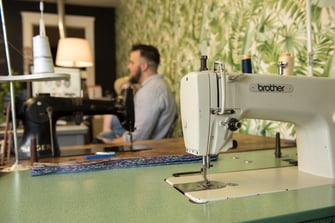 Marketing to makers starts like marketing to any other audience: you have to understand who they are, what they need, and how to connect with them in ways that matter. When we're talking about modern makers specifically, the key word is "authentic." But how does that factor in when we're trying to introduce your brand online? Are brands even welcome in the online communities created by and for makers and DIYers?
Marketing to makers starts like marketing to any other audience: you have to understand who they are, what they need, and how to connect with them in ways that matter. When we're talking about modern makers specifically, the key word is "authentic." But how does that factor in when we're trying to introduce your brand online? Are brands even welcome in the online communities created by and for makers and DIYers?
In this post, we'll let the makers answer that question for themselves. Then we'll give you our best tips for how to make genuine connections with makers in their own online communities. Keep reading to get started.
Are Brands Welcome in Online Maker Communities?
We won't keep you in suspense: according to the makers we've interviewed, yes, brands are indeed welcome in online maker communities, but only if they conduct themselves appropriately. The main complaint against brands who incorrectly step into makers' online spaces is that they're purely trying to sell their products. They clog up social feeds with thinly-veiled advertisements that don't imply an understanding of the makers they're speaking to. Makers see this as inauthentic and bothersome. Auto DIYer David Kidd explained why in our focus group: "When we go to these online communities, we want to be helped. We don't want to be sold to."
 Accessory designer Anne Skoch gave us some insight into some types of interactions makers value most during our focus group with makers who sew. She said that she would always appreciate a brand liking and commenting on her project photos to show they support her work. Anne also said that it means a lot to her when a brand reposts her photo for their own audience. Our panel agreed: the best way to show you understand and value the makers in your industry is to use your platform to shed a little light on what they're making.
Accessory designer Anne Skoch gave us some insight into some types of interactions makers value most during our focus group with makers who sew. She said that she would always appreciate a brand liking and commenting on her project photos to show they support her work. Anne also said that it means a lot to her when a brand reposts her photo for their own audience. Our panel agreed: the best way to show you understand and value the makers in your industry is to use your platform to shed a little light on what they're making.
 Finally, in both of these focus groups, makers brought up an alternative way that they'd love to see brands participating in their online communities: giving the actual makers the power to help you make your entrance. Lish of Neck & Tie Co. as well as Brian of Classic G-Body Garage both mentioned that they'd love to help brands enter these conversations by acting as reviewers or brand representatives. While this is a more advanced tactic that takes more resources, reaching makers through the peers that influence them could be a truly effective and natural way to get your foot in the door.
Finally, in both of these focus groups, makers brought up an alternative way that they'd love to see brands participating in their online communities: giving the actual makers the power to help you make your entrance. Lish of Neck & Tie Co. as well as Brian of Classic G-Body Garage both mentioned that they'd love to help brands enter these conversations by acting as reviewers or brand representatives. While this is a more advanced tactic that takes more resources, reaching makers through the peers that influence them could be a truly effective and natural way to get your foot in the door.
How to Enter Online Maker Communities as a Brand
Now that you know it's certainly possible to enter online maker communities as a brand, here are our best tips for getting started.
- Find target makers where they are. Depending on what type of makers you're looking for, they might congregate on different social platforms. For instance, we know that auto DIYers and some woodcrafters use forums, while crafters are often using Pinterest. You have to find the conversations where they're already happening before you can join them. To find most makers and DIYers, Instagram and Facebook Groups are great places to start.
- Observe first. Pay attention to the types of conversations makers start on their own before diving in with your opinions. Get used to the ways they respond to each other. This is the best way to learn how you can make a natural entrance. Learn through example how to speak to makers like they speak to each other.
 Start slow. Don't overrun their feed by starting tons of your own threads or replying to every comment. Be present and show your appreciation of their work to begin with. Like a photo here and there, and congratulate makers when they share their successes. Once you've established your brand as a casual member of the community, then you can ease into answering questions and sharing your own advice with the group.
Start slow. Don't overrun their feed by starting tons of your own threads or replying to every comment. Be present and show your appreciation of their work to begin with. Like a photo here and there, and congratulate makers when they share their successes. Once you've established your brand as a casual member of the community, then you can ease into answering questions and sharing your own advice with the group.- Help, don't sell. Here's where the biggest insight from our conversations with real makers comes in. Like we said earlier, makers participate in these online communities to get support, whether that means getting help with projects or simply finding others who understand their joys and struggles. What they're not looking for is an advertisement. We're not saying you have to promote someone else's product, but it's important to keep your comments focused on the topic at hand without constantly bringing up your own products. You gain the community's trust by adding value to the conversation with a genuine interest in helping makers succeed.
- Be human. Take the previous tip one step further by putting yourself on the same level as the makers you're connecting with. Talk to them like they're your peers and your friends, not just potential customers. Don't overuse jargon or come off as sales-pitchy. Let them get to know you, the person behind the brand, a little bit if you can. Putting yourself in the mindset of the maker means you're much more likely to become an integral and appreciated member of the conversation.
While some of these tips might seem simple on paper, they can be a little more difficult to put into action, especially if your brand is more used to writing Facebook ads than it is getting to know makers on an authentic level. If you ever need help finding or talking with makers, let us know. In the meantime, if you use these tips to create genuine connections in online maker communities, you're well on your way to getting back as much support as you put in.




